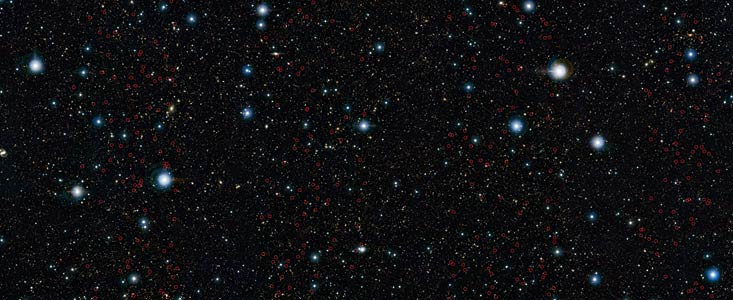The Birth of Monsters


ESO’s VISTA survey telescope has spied a horde of previously hidden massive galaxies that existed when the Universe was in its infancy. By discovering and studying more of these galaxies than ever before, astronomers led by Karina Caputi of the Kapteyn Astronomical Institute have, for the first time, found out exactly when such monster galaxies first appeared.
Just counting the number of galaxies in a patch of sky provides a way to test astronomers’ theories of galaxy formation and evolution. However, such a simple task becomes increasingly hard as astronomers attempt to count the more distant and fainter galaxies. It is further complicated by the fact that the brightest and easiest galaxies to observe — the most massive galaxies in the Universe — are rarer the further astronomers peer into the Universe’s past, whilst the more numerous less bright galaxies are even more difficult to find.
A team of astronomers, led by Karina Caputi of the Kapteyn Astronomical Institute at the University of Groningen, has now unearthed many distant galaxies that had escaped earlier scrutiny. They used images from the UltraVISTA survey, one of six projects using VISTA to survey the sky at near-infrared wavelengths, and made a census of faint galaxies when the age of the Universe was between just 0.75 and 2.1 billion years old.
UltraVISTA has been imaging the same patch of sky, nearly four times the size of a full Moon, since December 2009. This is the largest patch of sky ever imaged to these depths at infrared wavelengths. The team combined these UltraVISTA observations with those from the NASA Spitzer Space Telescope, which probes the cosmos at even longer, mid-infrared wavelengths.
“We uncovered 574 new massive galaxies — the largest sample of such hidden galaxies in the early Universe ever assembled,” explains Karina Caputi. “Studying them allows us to answer a simple but important question: when did the first massive galaxies appear?”
Imaging the cosmos at near-infrared wavelengths allowed the astronomers to see objects that are both obscured by dust, and extremely distant, created when the Universe was just an infant.
The team discovered an explosion in the numbers of these galaxies in a very short amount of time. A large fraction of the massive galaxies we now see around us in the nearby Universe were already formed just three billion years after the Big Bang.
“We found no evidence of these massive galaxies earlier than around one billion years after the Big Bang, so we’re confident that this is when the first massive galaxies must have formed,” concludes Henry Joy McCracken, a co-author on the paper.
In addition, the astronomers found that massive galaxies were more plentiful than had been thought. Galaxies that were previously hidden make up half of the total number of massive galaxies present when the Universe was between 1.1 and 1.5 billion years old. These new results, however, contradict current models of how galaxies evolved in the early Universe, which do not predict any monster galaxies at these early times.
To complicate things further, if massive galaxies are unexpectedly dustier in the early Universe than astronomers predict then even UltraVISTA wouldn’t be able to detect them. If this is indeed the case, the currently-held picture of how galaxies formed in the early Universe may also require a complete overhaul.
The Atacama Large Millimeter/submillimeter Array (ALMA) will also search for these game-changing dusty galaxies. If they are found they will also serve as targets for ESO’s 39-metre European Extremely Large Telescope (E-ELT), which will enable detailed observations of some of the first ever galaxies.
Source: press release ESO
More news
-
16 October 2025
Creating sustainable batteries to power the energy transition
-
15 October 2025
Night of the Night 2025
-
08 October 2025
Not all plastic needs to be bio-based or biodegradable
